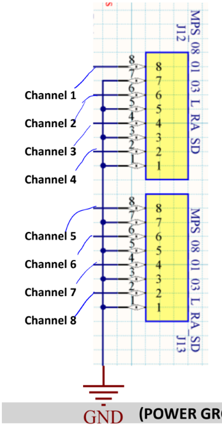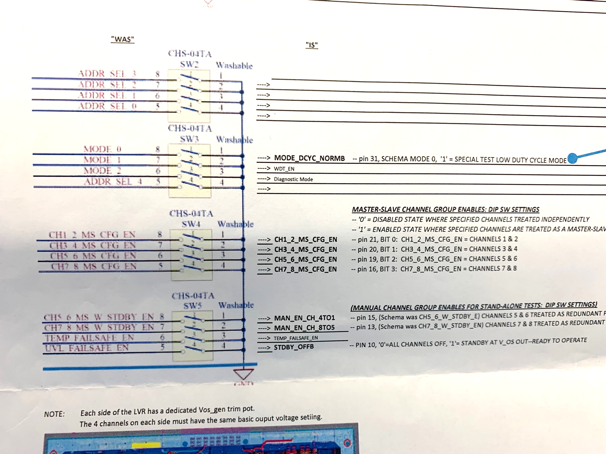LVR Configuration
Abstract
The following serves as a guide for general LVR operation as well as LVR QA procedures. The firmware loaded onto the LVRs by default does not allow for channels to be directly controlled. When power is connected the channels will come up in sequenced pairs (1-2, then 3-4, etc). It is therefore important that you only bring up Vin if you are okay with there being Vout. It is wise to first power up with the loads disconnected and verify the polarity and amplitude of the outputs. Beware doing this that if loads are disconnected from Vout but the sense lines remain hooked up the output will just jump to 5V.
Channels should not be left at 5V output for a long time. There is a resistor providing 220 Ohm minimal load, which is rated for 0.125W, but would have to dissipate 0.11W. Therefore, channels with power but no CCM should be set up as per "other unused channels" below, such that the power through this resistor is negligible.
Channel Sense lines
If RJ45 connections to the remote sense are unavailable (broken) the regulators will fall back on a local sense mode and regulate the output voltage at their connector instead. The sense line inputs follow RJ45 conventions:
| Channels | Pins |
|---|---|
| CH1 & 5 | 1 & 2 |
| CH2 & 6 | 4 & 5 |
| CH3 & 7 | 4 & 5 |
| CH4 & 8 | 7 & 8 |
Setting Up Monitor/Programmer
This section deal with setting up the monitor/programmer for the LVR.
To set up the programmer:
- Turn power off
- Connect jumpers between
J22pins 2 & 4 (V_pump) - Connect jumpers between
J22pins 1 & 3 (V_jtag) - Connect programmer to
J17. - Turn power on
- Initiate the program sequence
- Move jumpers on
J22to connect pins 4 & 6 and pins 3 & 5
To set up the monitor:
-
Connect Raspberry Pi leads to
J18.Note
Leads must start at pin row 3-4, not 1-2.
-
Turn on raspberry Pi and run code
V_SENSErefers to the output feedback voltage from the CCMV_REGUL_OUTrefers to full input voltagei_SENSE_MONrefers to current through resistor____
Fuse/Channel Configuration
This section deals with which channels are being used. Ideally fuses should be installed only for the channels to be used. Unfused is the safest state for an unused channel.
The input BBs are mislabeled:
| Label on fuse | Channels |
|---|---|
| F3-4 | CH5 & 6 |
| F1-2 | CH7 & 8 |
| F7-8 | CH1 & 2 |
| F5-6 | CH3 & 4 |
Input voltage should be set above the UVL (Undervoltage lockout) setting for that fuse group. As presently configured (pre-slice test) 5.5V appears adequate for all configurations, but this is subject to further study
Undervoltage lockout is configured via SW6A-SW6D (that is, one per fuse group). This circuit disables the associated channels if the input voltage falls below a threshold set by the switch. Within one SW4x, the four toggles form a 3-digit number LSB -> MSB, with the fourth toggle putting the channel in an always on state (override UVL).
It is best to be at least 0.25V, preferably 0.5V above the actual drop-out voltage, otherwise a channel may appear to be on, but when it actually tries to start the natural drop in Vin from the abrupt increase in current demand by the regulator causes the UVL to trip, leading to a series of false-start hiccups rather than actual starts.
Configuration of LVR
LVR Configuration is done via the CCMs and the potentiometers P3 and P4, which should be set according to the CCMs to be installed as
| Vos [V] | Vout [V] |
|---|---|
| 1.775 | 2.5 |
| 1.546 | 1.5 |
| 1.483 | 1.225 |
P3 controls CH1-CH4, P4 controls CH5-CH8, and each group of four must use the same CCM Vout. Vos may be measured across TP9-TP10 for CH1-4, and TP14-15 for CH5-8.
Normal versus Duty Cycle Mode
For Low Duty Cycle Pulsed mode, we enable this via setting SW3-1 to OFF. It provides a pulse every ~3 seconds that appears to last for ~60ms. Normal mode (or continuous mode) provides continuous transmission of voltage.
It is recommended that for operation periods greater than ~20 minutes to have the board on Duty Cycle Pulsed mode (30-45 min in extreme cases), whereas short operation periods can utilize continuous mode. This is to prevent overheating of 4913ADLHC regulator chips on LVR.
Master/slave pairings
Master slave pairs should ideally always be within a fuse group, and must follow ascending channel number. That is, CH1 is M and CH2 is S, or CH3 is M and CH4 is S, or CH5 is M and CH6 is S etc.
In addition to the appropriate CCM type, the firmware must be notified channels 2, 4, 6, 8 should be slaves or masters, via SW4. The ON setting of the switch corresponds to slave in a M+S pair, while the OFF state is the setting for single master.
| SW4 switch | Channels |
|---|---|
| 1 | CH2 |
| 2 | CH4 |
| 3 | CH6 |
| 4 | CH8 |
Note
When setting up master/slave CCM pairs, slave CCMs should always be on even numbered CCMs.


Note
In the current firmware, SW5 contains enables for CH1-4, CH5-8 and a global standby. To operate the regulator SW5 must be set as: (OFF, OFF, ON, OFF)

Tom's notes on the configuration switches for the LVR, including master/slave and general enables.
IMPORTANT
THE CONVENTION HERE IS OPPOSITE WHAT YOU EXPECT BECAUSE THESE ARE SHORTING PULL-UPS. "ON" ON THE SWITCH IS LOGIC 0 AND "OFF" IS LOGIC 1.
Also please note that the physical order is 3,2,4,5 and NOT 2,3,4,5.
Note that LVR Configuration is done via the CCMs and the potentiometers P3 and P4, which should be set according to the CCMs to be installed as
| Vos [V] | Vout [V] |
|---|---|
| 1.775 | 2.5 |
| 1.546 | 1.5 |
| 1.483 | 1.225 |
P3 controls CH1-CH4, P4 controls CH5-CH8, and each group of four must use the same CCM Vout. Vos may be measured across TP9-TP10 for CH1-4, and TP14-15 for CH5-8.
Overtemperature/Undervoltage Lockout
The overtemperature lockout is configured by SW1. SW1 represents a binary number with switch 1 the LSB and switch 4 the MSB. Settings which have been explored in the lab are (in big endian, LSB -> MSB)
| Binary setting | LVR shuts off at [C] |
|---|---|
0101 | 39 |
1101 | 30 |
1001 | 55 |
0001 | 70 |
The slice test could easily run at either of the last two.
The undervoltage lockout is configured by SW6(A, B, C, D). We note the following configurations for each SW6#. Note that if 4 in SW6#[1, 2, 3, 4] is ON, this acts as a bypass for all other switches. We therefore only consider switcher 1-3:
| SW6 switcher 1-3 | Undervoltage lockout at [V] |
|---|---|
0,0,0 | 5.9 |
1,0,0 | 5.4 |
0,1,0 | 5.1 |
0,0,1 | 4.6 |
1,1,0 | 5.1 |
0,1,1 | 4.1 |
1,1,1 | 3.9 |
1,0,1 | 4.6 |